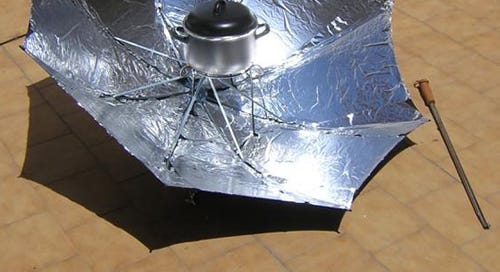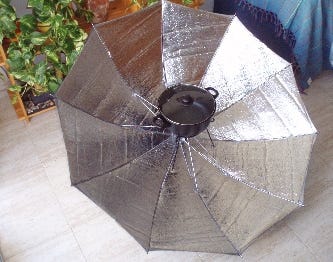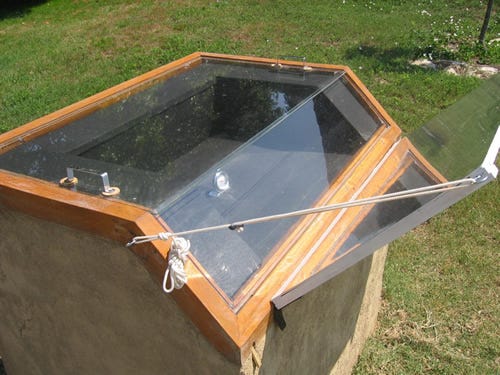In March 2009, I posted an essay about Solar Cooking to my subscribers, ten times more subscribers then than on Substack! I had been doing some minor charitable work for some projects in Africa and realized that for a pittance, one could be cooking without any fuel costs.
This post is a minor update. I was encouraged to send it by a subscriber who is not quite homesteading, but she has an organic farm. She was very surprised to learn that solar cooking has been successful even in the winter in places like Norway where the days are very short and the snow is deep. In any area with sunshine, this option is certainly worth knowing about.
For quite some years now, I have followed various solar projects and have a small portable solar stove that can be used in an emergency or for travel. The projects can be very simple or really sophisticated, like supporting an entire village with rows and rows of ovens or setting up bakeries and kitchens that depend 100% on the sun for cooking.
Read on!
In the shameless current state of affairs, many ought to be thinking about solar alternatives to conventional heating and cooking. This includes anyone who is concerned about energy costs or his or her own energy footprint, anyone who lives in makeshift housing as in the tent cities that now span the globe from refugee camps to suburbia, anyone who is progressive, innovative, and wants to be first in the neighborhood to step up to the plate, and anyone who just loves to be a tad different.
Let's take the practical matters first, solar cooking uses the rays of the sun, not the heat. There many videos on youtube.com posted by people who tested solar cookers in the snow in subzero cold, and the ovens work, oven reaching a boiling point in twenty minutes. Most attention is however placed on poor countries where deforestation is an issue because several problems can be conquered by one simple solution.
The simplest solar ovens involve lining a cardboard box or umbrella with aluminum foil. This saves money if people have been using kerosene or propane. It saves time if people, usually women, walk long distances to collect wood. It also reduces the risk of rape if women are alone in remote areas. They can spend more time with their families and perhaps engage in some remunerative work.
Additional Advantages
Many users have reported that solar cooked food tastes better. The food is more moist. Food does not burn and does not require stirring. Solar cooks thus avoid burns and their pots are easy to clean. Most importantly, they inhale less sooty smoke. Solar cookers can function as ovens or ranges, and those who like to grill can use the sun for this as well.
Options
There are countless, I mean countless, plans online for making your own solar cooker. You can also buy something as simple as a $30-40 portable grill or build a commercial model for a bakery or restaurant.
Basically, all that is needed is a reflective surface and sun. One can use aluminum foil, sheet metal, or glass, probably even sea shells. To absorb solar rays instead of reflecting them, pots need to be dark, not shiny. Temperatures reach up to around 400 or even 425 degrees Fahrenheit, that's over 200 degrees Celsius! Depending on the weather, it is possible to bring water to a boil in as little as 20 minutes. Because of the glare and reflection, eyes need protection. Wear sunglasses!
The simplest solar cookers are made of tin foil. Some people attach the tin foil to cardboard to give it more rigidity. Some line the inside of an umbrella and devise clever ways to track the sun so that the angle can be adjusted as the sun moves.
The most elegant units are built to last, often on cob or adobe pedestals with recessed areas for the pots and a glass enclosure. These can have externally mounted additional reflectors so that one takes full advantage of early morning as well as late afternoon sun even though the midday sun is the most valuable.
There is nothing much easier than putting a pot of rice or beans into a solar oven and then going about one's business for the day and coming back later to find everything ready to eat.
Over the last years, I have visited dozens and dozens of web sites with material on solar ovens. Some are providing ovens for as little as $5 to the people who are impoverished. This is a one-time expense for the user, and they will no longer have to cut trees or buy fuel to cook. Why didn't humanity invent this hundreds of years ago? If one compares solar cookers to gas and electric appliances, it is practically as though, technologically speaking, we are still rubbing sticks together to make fire. We don't need fire to cook, just the rays of the sun!
In terms of the third world use of solar ovens, my web surfing led me to conclude that most of the larger exports are being handled by religious charitable institutions (all creeds and denominations) and there are plenty of dot org solar sites. I do not see any comparable organization of effort in the U.S. or Europe. Given the magnitude of our poverty and homelessness, solar options should be a no brainer.
Solar ovens do not stand to replace conventional stoves in the near future but they can sterilize water, bake bread, cook casseroles, and perhaps most important of all is they tend to be more useful in the tropics because of the angle of the sun . . . and this just happens to be where we need to preserve our rain forests, ease the burden on impoverished people, and reduce the risk of fires. However, they work in the snow as seen in the one minute video below.
Solar cookers can also be used for food and herb dehydration. This extends the shelf life of produce so that foods can be used long after harvesting. They can be rehydrated when used in soups and casseroles, added as garnishes, blended to make teas, and used to make herbal medicines.
Copyright by Dr. Ingrid Naiman 2009 and 2023 || All Rights Reserved
Image Credit:
¹ Satellite Cooker: Peter Steele | Dreamstime.com
Excellent Plan for Solar Cooking:
http://www.solarcooking.org/plans/Presentacio-forn-solar-cob-en.pdf
Variety of Plans:
http://www.solarcooking.org/plans/
http://www.solarcooking.org/plans/paracuina.pdf
Food Dehydrator:
http://databasetracker.weebly.com/blog/solar-food-dryer-plans-pdf







